After hygiene, engineering controls are the next most important means of controlling exposure to hazardous chemicals. Engineering controls are anything that that is built or installed to separate people from chemical, biological or physical hazards, and can include fume hoods, biosafety cabinets, glove boxes, and blast protectors. For help in determining what type of engineering control is appropriate for your process, contact EHS (404-894-4635).
Fume Hoods
Fume hoods are containment devices used to control exposure of the hood user and lab occupants to hazardous or odorous chemicals by preventing their release into the laboratory. A secondary purpose is to limit the effects of a spill by partially enclosing the work area and drawing air into the enclosure by means of an exhaust fan. This inward flow of air creates a dynamic barrier that minimizes the movement of material out of the hood and into the lab. Fume hoods are safety equipment and should be reserved for handling hazardous or odorous materials. They should not be wasted by using them to store unwanted equipment, chemicals, or garbage.
General Information About Fume Hoods
- Recirculation of any laboratory fume hood exhaust air is prohibited
- Ductless fume hoods are prohibited
- Newly installed fume hoods at Georgia Tech shall either be Standard By-pass hoods or Variable Air Volume (VAV) hoods. Auxiliary-air hoods are generally prohibited unless special energy conditions or design circumstances exist.
- Low flow (AKA high efficiency) hoods are not permitted at Georgia Tech unless approved in advance, in writing, by GT EHS.
- Fume hoods shall not be located in front of air diffusers, or along busy walkways.
- The material that the fume hood interior walls, work surfaces, and the duct are made of is determined by the hood’s anticipated use. Most hoods are made of solid resin; ducts are generally stainless steel. Perchloric acid hoods are made of stainless steel.
General Rules Regarding Laboratory Fume Hoods
- Before beginning any work, assess the level of hazard presented by the material involved and use only hoods that have adequate face velocity
- Keep all work at least 6 inches behind the plane of the hood sash.
- Never put your head inside an operating laboratory hood to check an experiment.
- The plane of the sash is the barrier between contaminated and uncontaminated air.
- The sash must always be between the user and hood contents:
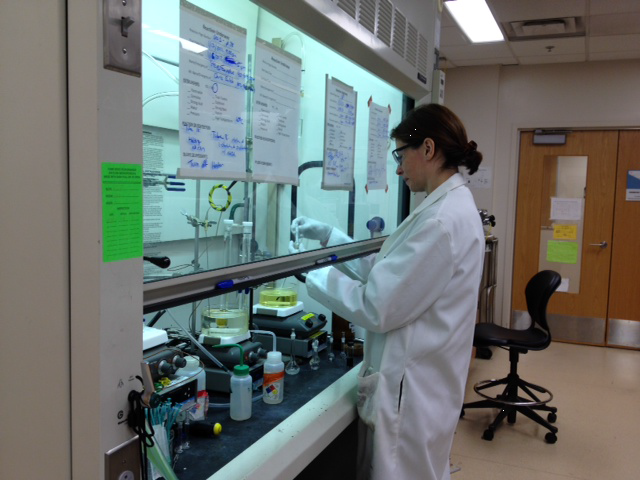
On hoods where sashes open vertically, work with the hood sash in the lowest possible position; this is generally elbow height. Never work with the sash in the fully open position.
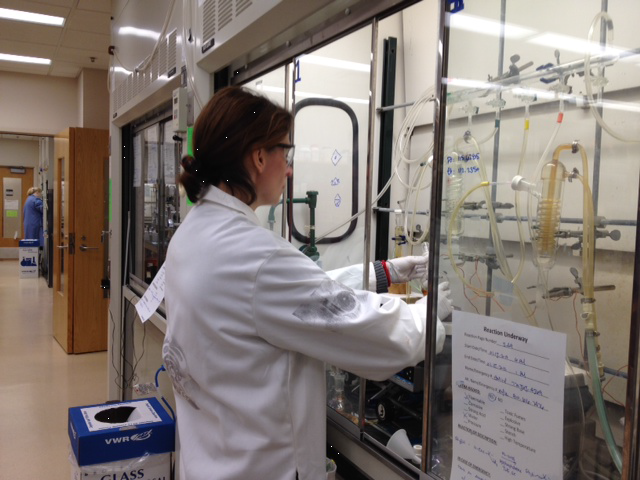
On hoods where sashes open horizontally, position one of the doors to act as a shield in the event on an accident in the hood.
- Keep hoods clean and clear; do not clutter with bottles or equipment. If there is a grill along the bottom slot or a baffle in the back of the hood, clean them regularly so they do not become clogged with papers and dirt.
- Allow only materials actively in use to remain in the hood. Extraneous chemicals left in an active hood can contribute to a fire or explosion.
- Elevate any equipment that needs to remain in hoods on racks or feet to provide airflow under the equipment.
- Post the name of the individual responsible for use of the hood in a visible location.
- Remove chemicals and clean hoods before maintenance personnel work on them.
- Hoods should have visible indicators that they are working. If the indicator is absent, hard to see, or not working, attach a piece of kimwipe to the sash in an area where it will not obstruct the work.
- Report suspected hood malfunctions promptly to your facilities area maintenance and also notify GT EHS at lab_chemsafety@gatech.edu
- Hoods operation shall be evaluated twice per year by GT EHS or a qualified third party and the inspection certified on a tag affixed to the front or side of the hood. If your hood does not have at GT EHS tag dated within the last six months, please report it to your facilities area maintenance and also notify GT EHS at lab_chemsafety@gatech.edu.
- General purpose hoods shall operate at 100 linear feet per minute (LFPM) ± 20%.
- Hoods used for highly toxic or carcinogenic materials shall operate at 120 LFPM ± 10%.
- Hoods should not, as a matter of course, operate above 150 LFPM to avoid the potential for dangerous turbulence that could result in exposure to the user.
- Always close the fume hood sash when you move away from the hood or leave the lab.
- Removal of fume hood access panels by anyone other that GT Facilities is prohibited.
- Tampering with fume hoods/fume hood exhaust ducts by adding additional equipment on to the load of the hood or cutting/drilling into exhaust ducts without consulting with EHS (404-894-4635) is prohibited.
Perchloric Acid Hoods
Perchloric acid is a clear liquid that has no odor. Solutions below 73% at room temperature are strong non-oxidizing acids. Perchloric acid becomes a strong oxidizer when heated or at higher concentrations; at or above 73%. Organic, metallic and non-organic salts formed from perchloric acid oxidation are shock sensitive and pose a serious fire and explosion hazard. There are many documented accidents resulting from the formation of perchloric acid salts.
Digestions and other procedures performed with perchloric acid at elevated temperatures must be done in a specially designed perchloric acid (wash down) fume hoods.
Perchloric acid hoods are equipped with water sources that spray the ducts and baffles of the hood to remove any perchlorates that may have formed there. Hoods must be washed down per the manufacturer’s recommendations after each use.
If procedures involving heated perchloric acid are performed only rarely, other accepted methods to capture and contain vapors may be used in place of a perchloric acid hood with EHS approval.
If you have been performing perchloric acid digestions in a fume hood not designed for perchloric acid, contact EHS at (404-894-4635) immediately for an evaluation of perchlorate contamination of the hood.
Perchloric acid hoods may only be used for perchloric acid processes. Other processes/chemicals may not be accomplished in perchloric acid hoods.
Local Exhaust Ventilation
Various forms of local exhaust ventilation are seen in GT Labs and may have been designed and installed for specific processes. These include:
[collapsed title=Elephant Trunk]
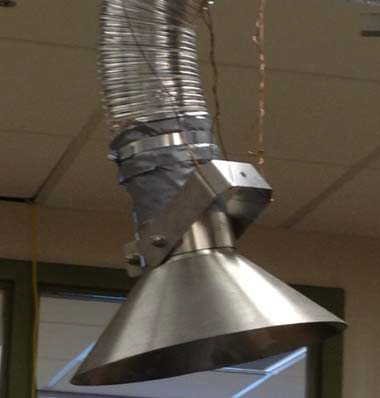
Are useful for small sources of emissions
[/collapse]
[collapsed title=Canopy]
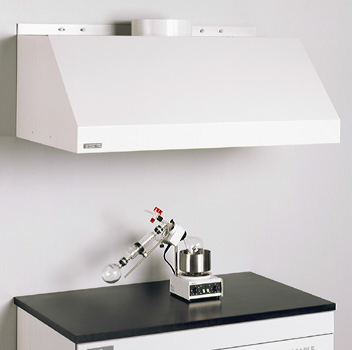
These are useful for hot operations or to exhaust materials that are lighter than air
[/collapse]
[collapsed title=Slot and Plenum]
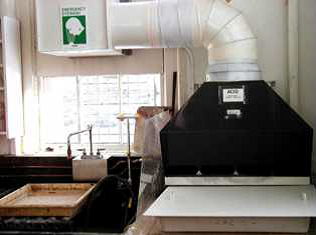
Are useful for heavy vapors or particulates because they pull the contaminant backwards, away from the user, into the plenum before exhausting it up and out
[/collapse]
Persons who have a need for local exhaust ventilation should contact EHS for an evaluation to determine what type of system will work best for your process.
Biosafety Cabinets and Laminar Flow Hoods

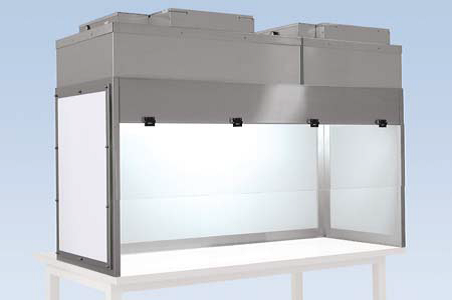
Laminar flow hoods are work benches that continuously bathe the work area with clean, filtered air. Their primary purpose is to protect what ever is being worked on, or "product", not the user. Some laminar flow hoods are also chemical benches which both protect the user and the products. These benches exhaust air via an exhaust ventilation system and do not recirculate it back into the lab.
Biosafety cabinets (BSCs) and laminar flow hoods (LFHs) are serviced and certified by a contracted vendor and documented by sticker affixed to the hood. Problems with BSLs or LFHs should be reported to the GT Biosafety Officer. If your hood does not have a sticker indicating that it has been serviced within the last 12 months, or if it does not have a sticker at all, please contact EHS (404-894-4635).
Ventilated Chemical Storage Cabinets
Ventilating chemical storage cabinets is regulated under National Fire Protection Association Standard 45, Standard on Fire Protection for Laboratories Using Chemicals. Ventilation of chemical storage cabinets may only be accomplished with prior approval by GT EHS and requires that the PI or designee start the installation process by filing a project request form with GT Facilities. Laboratory staff may not ventilate cabinets themselves.